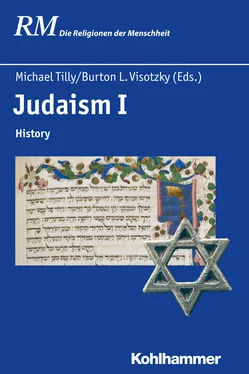In the 1230’s, Pope Gregory IX sent letters to the authorities of Christendom with the allegation that the Talmud contained demeaning references to Christianity. King Louis IX of France convened a court where Rabbi Yehiel of Paris defended the Talmud, while scholars from the university of Paris constituted the jury. They found the Talmud guilty and its manuscripts were burned. The Jews expelled from northwestern Europe proceeded eastward to economically less developed areas.
By the end of the first Christian millennium, the Jewish communities of Southern Europe were well rooted, especially on the Iberian Peninsula. Jews immigrated to Christian Spain and southern France as a result of the twelfth century invasion of the Almohade Muslims of North Africa. Rabbi Moses ben Maimon, who was born and studied in Muslim Spain left as a result. He was one of the towering intellects of all Jewish history. Major stimuli for Jewish creativity across medieval southern Europe came from the Islamic sphere.
In the thirteenth century, inquisitorial courts played a significant role in the Roman Church. The claim of heresy among the New Christians was a major factor in the expulsion of Jews from Spain in 1492. Jews made their way eastward into the Ottoman Empire.
7 Judaism During and After the Expulsions 1492–1750
Dr. Joseph Davis of Gratz College in Philadelphia writes that between 1492 and about 1750, when Moses Mendelssohn began the Jewish Enlightenment, Jews and Judaism remained in some ways »medieval,« while in other ways, they became cautiously and even precociously »modern.«
As expulsions of Jews from European countries continued, Jewish life in 1570 was at its lowest ebb in Western Europe. Recovery in the sixteenth century was remarkable. Ottoman authorities were eager to repopulate Istanbul, which eventually had a community of 40,000 Jews. The emigration of Jews from Western Europe also helped repopulate the Jewish communities of the land of Israel. In Istanbul, Salonika, Safed, and throughout the Mediterranean, the new Jewish communities were divided into ethnic subgroups of Jews.
In Poland, Jews also found policies of religious toleration. The Protestant Reformation, and the failure of Protestants and Catholics to convince one another, made Jewish »stubbornness« seem less exceptional. The expulsions from Western Europe ran their course, and about 1570 the tide of migration began to shift.
The sixteenth and early seventeenth century was an era of rabbis who adapted Jewish law to new circumstances, publishing responsa, commentaries, and codes of Jewish law. Poland and the Ottoman Empire stood out as major centers of Talmud study and halakhic creativity. Jewish mystics and Kabbalists immigrated to the land of Israel and settled in Safed. It and Jerusalem continued to attract great scholars in the seventeenth and eighteenth centuries. Alongside of halakhah and rabbinic literature, and sometimes in tension with it, kabbalah was the second great pillar of early modern Judaism.
Israel ben Eliezer, the Baal Shem Tov (»Master of the Good Name«) preached a new, spiritually democratic version of Judaism. He had a religious insight of enormous importance, »No place is empty of [God].« Besides its theology of radical Divine immanence, Hasidism introduced a variety of changes into Jewish life. The late seventeenth and early eighteenth centuries were a period of crisis in Jewish theology. However, the period was also one of increased political stability, compared to the war-filled mid-seventeenth century.
8 Modern Judaism 1750–1930
In this chapter, Dr. Dominique Bourel of the Centre Roland Mousnier at the French National Centre for Scientific Research (Sorbonne), considers Jewish modernity from the time of Spinoza (1632–77) until the post-World War I period. He writes of five changes of paradigm after the cultural revolution of the Eighteenth Century in Europe: 1) Moses Mendelssohn and the Jewish enlightenment ( Haskalah) , 2) the birth and solidification of Hasidism, 3) Wissenschaft des Judentums (Jewish studies), 4) the debate between Orthodoxy and Reform, and 5) the emergence of Zionism. These paradigms also operated in cultures of the Jews in the East, in Poland and in Russia. They were a new attempt to negotiate entry into European modernity.
Bourel sees a strong cultural hegemony in German-Jewish institutions and leadership. He describes how they navigated from an inner-focus on Judaism to a post-Enlightenment movement toward the non-Jewish world. Although these attempts at modernity did not succeed in integration into the German milieu (witness the Shoah), nevertheless, the five paradigmatic shifts sufficed to bring Judaism into modernity in the United States and the State of Israel. Bourel also briefly considers the role of Jewish women in advancing the community to modernity.
9 The Holocaust and Antisemitism
Dr. Michael Berenbaum of the American Jewish University in Los Angeles surveys the years before and during the Holocaust. Economic, social, populist, religious, and governmental conditions facilitated Hitler’s rise. Enmity toward the Jews was expressed by the church’s teachings of contempt. The Nazis’ racial definition meant Jews were persecuted not just for their religious practices, but because of their so-called racial identity. The Nazi Party destroyed democracy from within. By the time emigration was prohibited, more than six in ten German Jews had fled into exile.
In March 1938, German troops entered Austria. The persecution of Jews began the night of 9‒10 November 1938, known as Kristallnacht. More than a thousand synagogues, their Torah scrolls, bibles, and prayer books were burned. 30,000 Jewish men were arrested and sent to concentration camps in Germany. In 1940, Germany attacked Belgium, France, Denmark, Luxembourg, the Netherlands, and Norway. With each conquest, more Jews came under German control. With the exception of Amsterdam, ghettos were not present in Western Europe. Further east, after June 1941, ghettos were imposed after the Einsatzgruppen , mobile killing units, had done their murderous work. Except for Denmark, western Jews were persecuted, rounded up, incarcerated in transit camps, and sent to death camps in occupied Poland.
The Final Solution became policy in 1941. Six »death factories« allowed the Nazis and their collaborators to murder Jews, confiscate their goods, and dispose of the bodies to hide their crimes. The final stage was an attempt by the perpetrators to evacuate the Jews from the most horrific concentration camps—where German troops and their collaborators could be caught in war crimes. In the waning days of World War II American troops discovered the concentration camps of Ohrdruf, Mauthausen, Nordhausen, Buchenwald, and Dachau.
The Nuremberg Trials, convened by President Harry S. Truman, were undertaken by the United States, Great Britain, the Soviet Union, and France. Raphael Lemkin, a Polish-Jewish émigré to the United States and international lawyer, wrote of the need to name and outlaw the crime. The word he chose was »genocide«—the murder of a people. He pushed The Convention on Genocide through the United Nations in December 1948.
10 Zionism and the State of Israel
Dr. Martin Kloke of Cornelsen Publishing, Berlin, notes the biblical roots of Zion before considering nineteenth-century Zionism and Herzl’s vision. Between 1882 and 1903, twenty- to thirty-thousand Jews came to Palestine. This number doubled between 1904 and 1914. Ottoman pressures radicalized Jews. Chaim Weizmann lobbied for British recognition. Following World War I, in which the Ottomans aligned with Germany, the Zionist-friendly Balfour declaration was promulgated.
The British invasion of Palestine in 1918 ended the four-hundred-year reign of the Turks. In 1919, Emir Feisal of Mecca accepted Jewish immigration to Palestine. But by 1928, the economic recovery of the Jewish Yishuv caused fear among the Arabs. Muslims and Jews engaged in street battles, while the authorities stood aside. Organized labor was important for the socio-economic development of the Yishuv. When in 1933, the Nazis began systematic discrimination against Jews, around 38,000 new immigrants came to Palestine. They were followed by 197,000 refugees from Poland. Zionists intensified efforts to smuggle Jewish refugees. World opinion could no longer overlook the murder of six million European Jews.
Читать дальше







